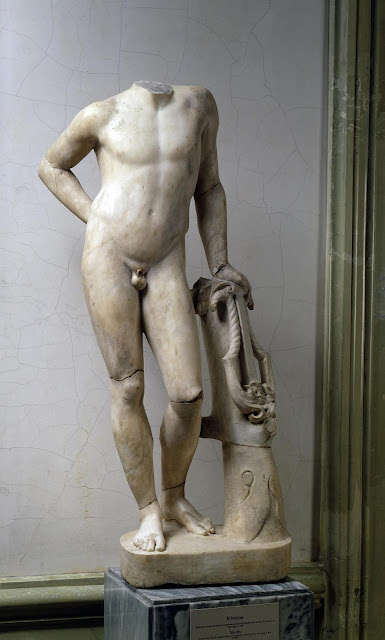 |
| workshop of Gianlorenzo Bernini Portrait-head of Bernini 1680s terracotta Hermitage, Saint Petersburg |
The portrait head of Gianlorenzo Bernini (1598-1680) was produced in the decade after his death by members of his busy and loyal Roman workshop. It eventually made its way to Russia and the Hermitage, along with other studio material. The bozzetto was a small terracotta model or sketch used by sculptors like Bernini to work out the forms to be rendered later on a larger scale in marble or bronze. A collection of these bozzetti in Saint Petersburg gives an immediate and vivid impression of the swirling spirals Bernini elaborated as a preliminary to each commission.
 |
| Gianlorenzo Bernini Tritons with Dolphins ca. 1653 terracotta Hermitage, Saint Petersburg |
 |
| Gianlorenzo Bernini Torso of Pluto ca. 1621-22 terracotta Hermitage, Saint Petersburg |
 |
| Gianlorenzo Bernini Torso of Neptune 1622 terracotta Hermitage, Saint Petersburg |
 |
| Gianlorenzo Bernini Angel before 1680 terracotta Hermitage, Saint Petersburg |
 |
| Gianlorenzo Bernini Angel ca. 1670-75 terracotta Hermitage, Saint Petersburg |
 |
| Gianlorenzo Bernini Abduction of Proserpine before 1680 terracotta Hermitage, Saint Petersburg |
 |
| Gianlorenzo Bernini Prophet Habbakuk and Angel before 1680 terracotta Hermitage, Saint Petersburg |
 |
| Gianlorenzo Bernini Daniel in the Lion's Den before 1680 terracotta Hermitage, Saint Petersburg |
 |
| Gianlorenzo Bernini St Ambrose ca. 1657 terracotta Hermitage, Saint Petersburg |
 |
| Gianlorenzo Bernini Ecstasy of St Teresa 1640s terracotta Hermitage, Saint Petersburg |
 |
| Gianlorenzo Bernini Blessed Ludovica Albertoni ca. 1672 terracotta Hermitage, Saint Petersburg |
 |
| Gianlorenzo Bernini David 1623 terracotta Hermitage, Saint Petersburg |
 |
| Gianlorenzo Bernini Constantine the Great ca. 1662-63 terracotta Hermitage, Saint Petersburg |
"Architects who say, 'I don't think I can or should control the whole environment' are usually in fact claiming control. Rather than simply accepting any interference to their vision that might occur, they insist upon indeterminacy or incompletion to regain control of those zones that elude them. They label them as danger or pleasure zones – red light districts, in a sense. And, of course, red light districts are never all that dangerous; usually they are highly regulated and predictable. If you study the work of these architects, you will find no gaps. Every potential gap is labeled 'gap' and thereby brought back into line. Incompletion is an aesthetic. It is a design choice, and a good choice for many designers."
– from Whatever Happened to Total Design? by Mark Wigley (1998)










































